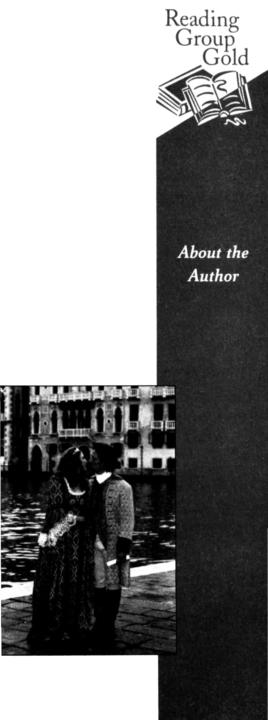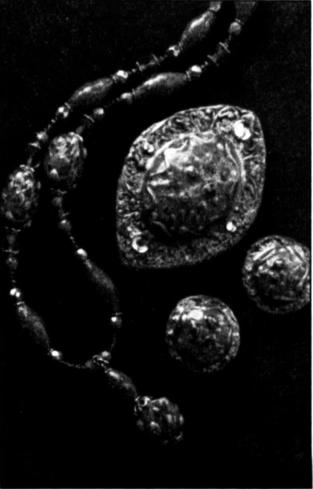The Glassblower of Murano (33 page)
Read The Glassblower of Murano Online
Authors: Marina Fiorato
"I love the way
glass is such a
shifting entity.
In many ways it
has as many
faces as Venice
itself"
Are there any parallels between you and Leonora? Can
you tell us a bit about your own travels in Venice and
experiences with glassblowing?
There are a number of parallels between myself and
Leonora, mostly to do with our heritage. Like her, I
have a Venetian family. I was actually lucky enough to
study at the University of Venice for six months and I
lived on the Lido, taking the vaporetto into Ca' Foscari
every day, which was wonderful. While there I remember taking a tourist trip to Murano, where I saw a glassblower make a tiny, perfect crystal horse in about sixty
seconds. I remember that it seemed like a miracle, and
the episode stayed with me; in fact it's included in the
book when Giacomo makes a glass horse for the young
Corradino. I returned to Venice years later to get married, in a little church on the Grand Canal. The whole
wedding party was in eighteenth-century dress, which
was fabulous, and we took boats out to the islands for
the reception. It was unforgettable.
You've mentioned that one of your favorite blown glass
windows in Venice is at Ca' Foscari, a palace on the
waterfront of the Grand Canal. What do you see when
you look at that window, in particular, and all blown
glass, in general? What is it about Venice, blown glass,
and the process of glassblowing that you hoped to reveal
to your readers?
There are hundreds of beautiful windows on the Grand
Canal, but Ca' Foscari has a special resonance for me
because of studying there. Originally a palace, Ca'
Foscari is now used as a university and stands in a particularly beautiful bend of the canal; what fascinates me
is that the window itself is as beautiful as what you can
see through it. I like the way that these windows also
tell the story of Venice's history-they are a wonderful
hybrid of western and eastern design and exemplify
Venice's identity, a republic standing astride two
empires.
Blown glass fascinates me because, like most great
crafts, it's incredibly difficult to achieve a good result. I
used the word miraculous in the book and I think it's
deserved. I love the way glass is such a shifting entity.
In many ways it has as many faces as Venice itself, and I
think that nature of changeability, of having many faces,
is what I wanted to reveal about the city. Glass begins
life as a powder which becomes liquid, then solid;
there's only a very short window to work with glass
before it hardens, and it takes a true artist to do it.
Incredible, too, that such beauty comes from humble
sand-true artistry from a quintessence of dust.
Venice is so unchanging; it's essentially the same place
architecturally as it was in the seventeenth century. There
are few places in the world about which one can say this,
because most cities have changed to accommodate roads
and sprawling suburbs. But because Venice as a "character" was the same then as now, I thought it would be
really interesting to take a look at ideas of heritage and
continuity of a particular Venetian family, with a peculiar
creative genius. I was interested in whether or not a
skill like glassblowing is
passed down in the same
way that, say, facial characteristics are. Is glassblowing
in the Venetian DNA? Are
these skills built into the
Venetian genome, and how
much does the city itself
create artists by a kind of
osmosis which has nothing
to do with the century they
are in? These are the kinds
of questions which interested me.
co
0

Marina's wedding kiss

The History of Murano
An Original Essay by the Author
"Murano is the
glass heart of
Venice."
When writing the historical strand of The Glassblower
of Murano it was important to me to get some sense of
the significance of glass in Venice at the end of the
seventeenth century. And when you visit, the evidence
is before your eyes; the city seems to be almost made of
glass. As well as boasting the most beautiful windows in
the world, exquisite chandeliers hang from the frescoed
ceilings of every palazzo, the basilica is clothed in jewellike mosaics comprised of nuggets of glass covered in
lapis and gold; and at the other end of the scale the
streets in the Merceria dell'Orologio behind San Marco
are crowded with bijoux little shops crammed with
glass fancies, beads, and bonbons.
But it is Murano, one of the trio of islands set far into
the Venetian lagoon, which is and was the glass heart of
Venice. In 1291, an edict of the Great Council, Venice's
ruling body, decreed that all glass furnaces should be
moved to the island after a series of serious fires which
threatened the city. In the Renaissance period, glass was
a priceless monopoly for the Republic of Venice, and
at the heart of their mystery was the closely guarded
secret of how to make mirrors. The manufacture of
mirrors of reasonable size and reflectivity was deeply
problematic until the glassblowers of Murano stumbled
across the optimum method through an accident of
glassblowing. Thereafter they began to make mirrors
brighter, clearer, and larger than any in the world.
Venetian mirrors quickly became the Republic's most
valuable commodity, more precious than saffron; more
costly than gold.
The Council of Ten, the vicious ruling junta of Venice's
Great Council, quickly realized the value of the glassblowers of Murano, and threatened them with death if
they ever divulged their methods. Often, the glassblowers' entire families were kept as hostages by the state.
Venetian law was very clear on the matter:
If any worker or artist should transport his talents to another country, and if he does not obey the order to
return, all of his closest relatives will be put in prison.
Incredibly, despite such threats, some of the glassblowers of Murano did betray their secrets and their city. In
the 1680s, Louis XIV, the Sun King, was in the throes
of his Grand Design: the Palace of Versailles, for which
he planned to construct a great chamber made entirely
out of mirrors, and needed assistance from the best of
the best. Thus, many of Murano's glassblowers were
secretly transported to Paris. Recruited by Pierre de
Bonzi, the French Ambassador to Venice, they were
tempted by tales of foreign lands, exotic women, and
great riches. By the autumn of 1665, twenty Murano
fugitives had been spirited away to Paris where they
began work upon the task of making the dream of a
king a reality.
C
O
CC
7

Fiorato beads. Image courtesy of Ann Mitchell and
Karen Mitchell of AnKara Designs,
www.ankaradesigns.com.

""It's great to be,
in some small
way, part
of such a
wonderful
tradition."
As we now know, the Hall of Mirrors in Versailles was
built and remains for all to see-a cathedral of glass
that is undeniably one of the modern wonders of the
architectural world. Not only does the work mitigate
the treachery of those brave souls from Murano, it is
also a tribute to the craftsmen of France, who would
someday become the forerunners for the genius of
Baccarat and Lalique.
On a more personal note, I made a discovery of my
own while researching the history of glassmaking in
Murano: I was delighted to discover that Fiorato, my
Venetian family name (which means "floral"), is also the
name for a type of Murano glass. Fiorato glass features
tiny glass flowers enameled and fused into beads.
Fiorato beads are tiny, but they are beautiful. It felt
great to be, in some small way, part of such a
wonderful tradition.
A portion of the essay originally appeared in Italian magazine
(© 2008). Reprinted with permission from the author.

Recommended Reading
The Count of Monte Cristo
by Alexandre Dumas
A wonderful epic tale of a man who comes back
from the "dead:' A direct influence on my
historical plotline.
The Comfort of Strangers
by Ian McEwan
An extremely dark take of Venice, in contrast
to the way in which the city is usually portrayed in
literature. McEwan creates a wonderful sense of
unease throughout. Here, the city is dangerous;
it can kill, and it does.
Brideshead Revisited
by Evelyn Waugh
One of my favorite novels. Tucked in the central
section is one of the most golden, languid portraits
of Venice ever written. Entirely seductive, the city
here is the polar opposite of the one in
The Comfort of Strangers.
Hannibal
by Thomas Harris
Another one of my favorites. Not a Venetian
setting but half of the novel is set in Florence and
it's a wonderful portrait of a city which has never
left the beautiful, brutal Renaissance. Everything is
here; the art, the corruption of those in power, and,
of course, the bloodletting.
